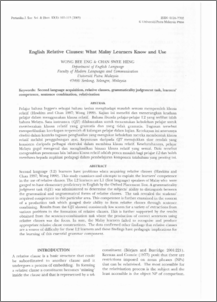Citation
Wong, Bee Eng and Chan, Swee Heng
(2005)
English relative clauses: what Malay learners know and use.
Pertanika Journal of Social Sciences & Humanities, 13 (1).
pp. 107-115.
ISSN 0128-7702; ESSN: 2231-8534
Abstract
Second language (L2) learners have problems when acquiring relative clauses (Hawkins and Chan 1997; Wong 1999). This study examines and attempts to explain the learners' competence in the use of relative clauses. The L2 learners are L1 (first language) speakers of Malay who were gauged to have elementary proficiency in English by the Oxford Placement Test. A grammaticality judgment task (GJT) was administered to determine the subjects' ability to distinguish between the grammatical and ungrammatical forms of relative clauses. The task revealed the students'
acquired competence in this particular area. This competence is further examined in the context of a production task which gauged their ability to form relative clauses through sentence combining. Results from the GJT showed consistently low scores for a variety of extractions from various positions in the formation of relative clauses. This is further supported by the results obtained from the sentence-combination task where the production of correct sentences using relative clauses was the focus. In sum, the Malay learners failed to recognise and produce
appropriate relative clause constructions. The data confirmed other findings that relative clauses are a source of difficulty for these L2 learners and these findings have pedagogic implications for the learning of this essential grammar component.
Download File
![[img]](http://psasir.upm.edu.my/style/images/fileicons/application_pdf.png)  Preview |
|
PDF
English_Relative_Clauses_What_Malay_Learners_Know_and_Use.pdf
Download (3MB)
|
|
Additional Metadata
Actions (login required)
 |
View Item |

